1、实现C++ STL向量容器vector代码
模板 =》 实现一个C++ STL里面的一个顺序容器 vector 向量容器(底层是数组,内存是连续的,2倍扩容
vecotor:使用了三个指针!!!
#include <iostream>
using namespace std;
template<typename T>//初始化,让用户不用指定,用默认的
class vector
{
public:
vector(int size = 10)//构造函数
{
_first = new T[size];
_last = _first;
_end = _first + size;
}
~vector()//析构函数
{
//析构容器有效的元素,然后释放_first指针指向的堆内存
delete[]_first;
_first = _last = _end = nullptr;
}
//重写拷贝构造函数
vector(const vector<T>& rhs)
{
int size = rhs._end - rhs._first;//空间大小
_first = new T[size];
int len = rhs._last - rhs._first;//有效数据的长度
for (int i = 0; i < len; ++i)
{
_first[i] = rhs._first[i];
}
_last = _first + len;
_end = _first + size;
}
//重写赋值重载函数
vector<T>& operator=(const vector<T>& rhs)
{
if (this == &rhs)
return *this;
delete[]_first;
int size = rhs._end - rhs._first;
_first = new T[size];
int len = rhs._last - rhs._first;
for (int i = 0; i < len; ++i)
{
_first[i] = rhs._first[i];
}
_last = _first + len;
_end = _first + size;
return *this;
}
void push_back(const T& val)//向容器末尾添加元素
{
if (full())
expand();
*_last++ = val; //_last指针指向的内存构造一个值为val的对象
}
void pop_back()//从容器末尾删除元素
{
if (empty())
return;
--_last;
}
T back()const//返回容器末尾的元素的值
{
return *(_last - 1);
}
bool full()const { return _last == _end; }
bool empty()const { return _first == _last; }
int size()const { return _last - _first; }
private:
T* _first;//指向数组起始的位置
T* _last; //指向数组中有效元素的后继位置
T* _end;//指向数组空间的后继位置
void expand()//容器的二倍扩容
{
int size = _end - _first;
T *ptmp = new T[2 * size];
for (int i = 0; i < size; ++i)
{
ptmp[i] = _first[i];
}
delete[]_first;
_first = ptmp;
_last = _first + size;
_end = _first + 2 * size;
}
};
int main()
{
vector<int> vec;
for (int i = 0; i < 20; ++i)
{
vec.push_back(rand() % 100);
}
while (!vec.empty())
{
cout << vec.back() << " ";
vec.pop_back();
}
cout << endl;
return 0;
}
上面用类模板实现了一个容器类!
上面写的和容器中的vector有什么区别?
- 缺一个非常重要的东西:空间配置器allocator!!!
STL中的vector:

问题:容器为什么要用空间配置器allocator,不用会怎么样?
2、理解容器空间配置器allocator的重要性
重要性:
- 容器的空间配置器allocator 做四件事情 内存开辟/内存释放 对象构造/对象析构
如果我们不使用空间配置器,仅仅是实现普通的vector类;
我们定义一个测试类Test:
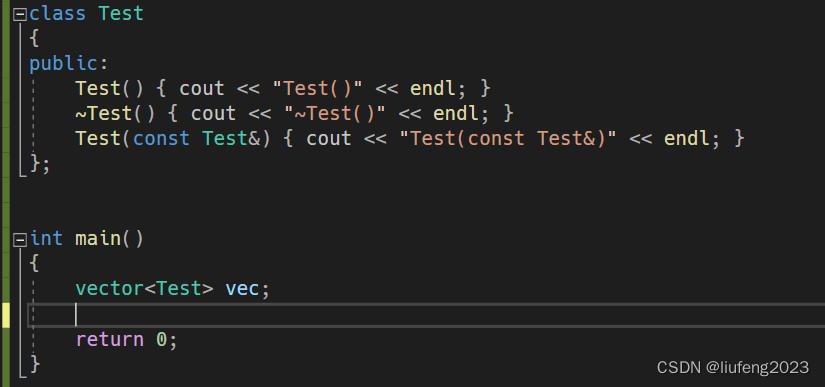
现在只是定义了一个vector,没有push过元素。
但是运行一下

一个空容器,竟然构造了10个Test对象,出作用域析构的时候,析构了10个Test对象。
但是目前我们就定义了一个空容器,没有放任何东西,为什么要构造这么多对象出来?
- 因为我们在vector的构造函数中使用了new操作了,不仅仅开辟了空间,还在每个内存空间上构造了对象;
- 这对象不是我们想要的,如果我们传了1000,只是定义了容器,但是又构造了1000次,析构1000次,这不合理!!!

我们在构造时需要把内存开辟和对象构造分开处理!!!
- 当我定义容器对象的时候,底层应该只是负责开辟空间而已,不能去构造对象的!
- 析构的时候,不能直接用delete,delete相当于数组的每个元素都当做有效对象去析构了,我们应该怎么操作?
数组可能很长,但是里面可能只有几个元素:

我们应该是在容器不需要的时候,把里面的有效元素析构掉,然后把整个数组的内存释放掉。析构函数应该是析构容器有效的元素,然后释放_first指针指向的堆内存。)
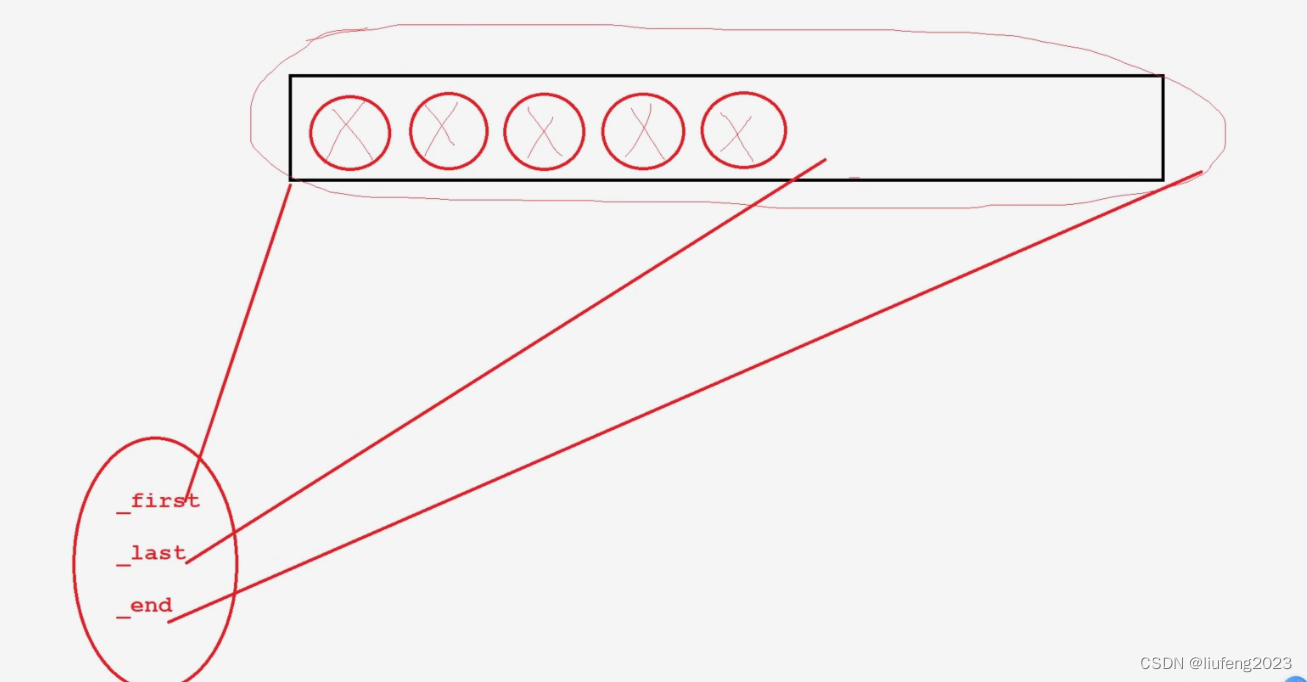
我们写代码进行测试:
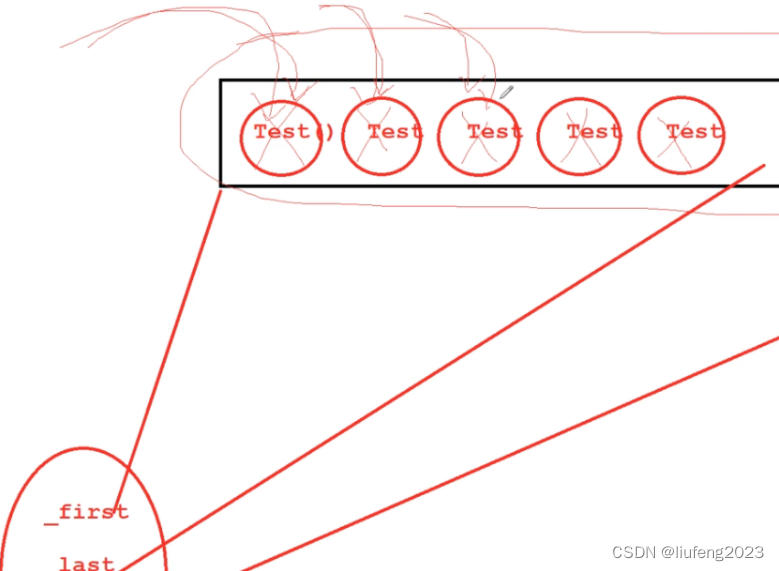
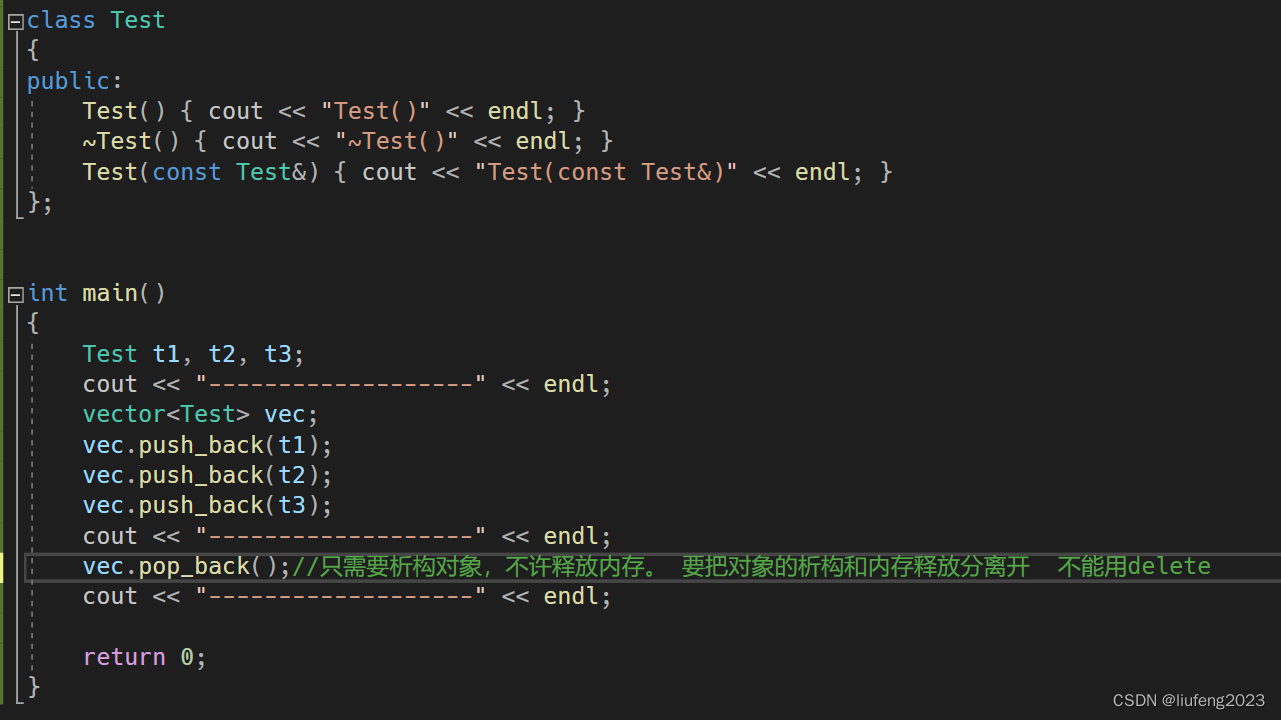
push_back:
- 按道理来说,push_back之前,容器只开辟了内存,没有在内存上构造对象;
- 当执行push_back的时候,这里的t1,t2,t3相当于在容器底层的某一块内存上构造新对象。
- 但是现在不是这样,现在生成容器的时候底层是用new,相当于容器的每个内存空间都放了一个Test对象,相当于是把t1,t2,t3去给Test对象赋值,这个逻辑不正确!!!
pop_back:
- 对于pop_back,这个容器底层的对象很可能有占用外部资源;
- 而现在的pop_back只是把last指针,减减了而已,这个外部资源很可能找不到了,被下次push_back的新的指针覆盖了。
- pop_back的对象很可能占用外部资源,不能不管。(之前的代码是没有管的,只是指针–)

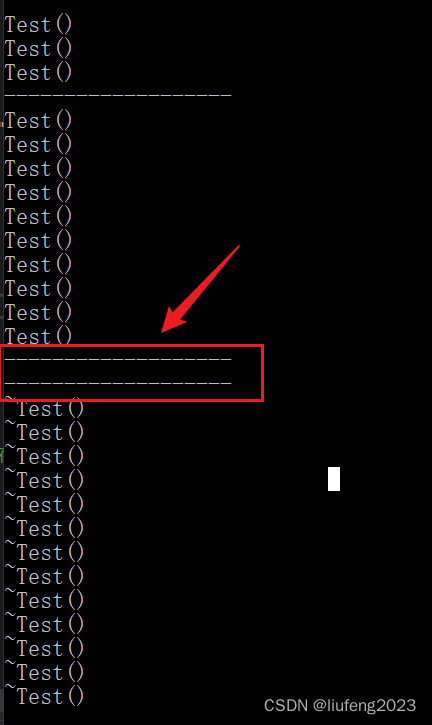
而且我们还不能用delete去释放它, 因为delete不仅仅析构对象和外部资源,还把这个数组的内存空间给free掉了。

在内存管理中,我们不能直接用new和delete:
- new:内存开辟和对象构造在一起;
- delete:对象析构和内存释放在一起;
因此我们要将 内存开辟/内存释放 对象构造/对象析构 分开。
#include <iostream>
using namespace std;
template<typename T>//初始化,让用户不用指定,用默认的
class vector
{
public:
vector(int size = 10)//构造函数
{
_first = new T[size];
_last = _first;
_end = _first + size;
}
~vector()//析构函数
{
//析构容器有效的元素,然后释放_first指针指向的堆内存
delete[]_first;
_first = _last = _end = nullptr;
}
//重写拷贝构造函数
vector(const vector<T>& rhs)
{
int size = rhs._end - rhs._first;//空间大小
_first = new T[size];
int len = rhs._last - rhs._first;//有效数据的长度
for (int i = 0; i < len; ++i)
{
_first[i] = rhs._first[i];
}
_last = _first + len;
_end = _first + size;
}
//重写赋值重载函数
vector<T>& operator=(const vector<T>& rhs)
{
if (this == &rhs)
return *this;
delete[]_first;
int size = rhs._end - rhs._first;
_first = new T[size];
int len = rhs._last - rhs._first;
for (int i = 0; i < len; ++i)
{
_first[i] = rhs._first[i];
}
_last = _first + len;
_end = _first + size;
return *this;
}
void push_back(const T& val)//向容器末尾添加元素
{
if (full())
expand();
*_last++ = val; //_last指针指向的内存构造一个值为val的对象
}
void pop_back()//从容器末尾删除元素
{
if (empty())
return;
--_last;
}
T back()const//返回容器末尾的元素的值
{
return *(_last - 1);
}
bool full()const { return _last == _end; }
bool empty()const { return _first == _last; }
int size()const { return _last - _first; }
private:
T* _first;//指向数组起始的位置
T* _last; //指向数组中有效元素的后继位置
T* _end;//指向数组空间的后继位置
void expand()//容器的二倍扩容
{
int size = _end - _first;
T *ptmp = new T[2 * size];
for (int i = 0; i < size; ++i)
{
ptmp[i] = _first[i];
}
delete[]_first;
_first = ptmp;
_last = _first + size;
_end = _first + 2 * size;
}
};
class Test
{
public:
Test() { cout << "Test()" << endl; }
~Test() { cout << "~Test()" << endl; }
Test(const Test&) { cout << "Test(const Test&)" << endl; }
};
int main()
{
Test t1, t2, t3;
cout << "-------------------" << endl;
vector<Test> vec;
vec.push_back(t1);
vec.push_back(t2);
vec.push_back(t3);
cout << "-------------------" << endl;
vec.pop_back();//只需要析构对象,不许释放内存。 要把对象的析构和内存释放分离开 不能用delete
cout << "-------------------" << endl;
return 0;
}
这就引出了容器空间配置器!
容器的空间配置器allocator 做四件事情 内存开辟/内存释放 对象构造/对象析构
#include <iostream>
using namespace std;
//定义容器的空间配置器,和C++标准库的allocator实现一样
template<typename T>
struct Allocator//模板类 struct定义 默认公有的
{
T* allocate(size_t size)//负责内存开辟
{
return (T*)malloc(sizeof(T) * size);
}
void deallocate(void* p)//负责内存释放
{
free(p);
}
void construct(T* p, const T& val)//在开辟好的内存上进行对象构造
{
new (p) T(val);//定位new
}
void destroy(T* p)//负责对象析构
{
p->~T();//~T()代表了T类型的析构函数 p指向的对象的析构
}
};
/*
容器底层内存开辟,内存释放,对象构造和析构,都通过allocator空间配置器来实现
*/
template<typename T, typename Alloc = Allocator<T>>//初始化,让用户不用指定,用默认的
class vector
{
public:
vector(int size = 10)//构造函数
{
//需要把内存开辟和对象构造分开处理
//_first = new T[size];
_first = _allocator.allocate(size);
_last = _first;
_end = _first + size;
}
~vector()//析构函数
{
//析构容器有效的元素,然后释放_first指针指向的堆内存
//delete[]_first;
//先析构对象
for (T* p = _first; p != _last; ++p)
{
_allocator.destroy(p);//把_first指针指向的数组的有效元素进行析构操作
}
//再释放内存
_allocator.deallocate(_first);//释放堆上的数组内存
_first = _last = _end = nullptr;
}
//重写拷贝构造函数
vector(const vector<T>& rhs)
{
int size = rhs._end - rhs._first;//空间大小
//_first = new T[size];
//内存开辟
_first = _allocator.allocate(size);
int len = rhs._last - rhs._first;//有效数据的长度
//对象构造
for (int i = 0; i < len; ++i)
{
//_first[i] = rhs._first[i];
_allocator.construct(_first + i, rhs._first[i]);
}
_last = _first + len;
_end = _first + size;
}
//重写赋值重载函数
vector<T>& operator=(const vector<T>& rhs)
{
if (this == &rhs)
return *this;
//delete[]_first;
//先析构对象
for (T* p = _first; p != _last; ++p)
{
_allocator.destroy(p);//把_first指针指向的数组的有效元素进行析构操作
}
//释放内存
_allocator.deallocate(_first);
int size = rhs._end - rhs._first;
//_first = new T[size];
_first = _allocator.allocate(size);
int len = rhs._last - rhs._first;
for (int i = 0; i < len; ++i)
{
//_first[i] = rhs._first[i];
_allocator.construct(_first + i, rhs._first[i]);
}
_last = _first + len;
_end = _first + size;
return *this;
}
void push_back(const T& val)//向容器末尾添加元素
{
if (full())
expand();
//*_last++ = val; _last指针指向的内存构造一个值为val的对象
_allocator.construct(_last, val);
_last++;
}
void pop_back()//从容器末尾删除元素
{
if (empty())
return;
//--_last; //不仅要把_last指针--,还需要析构删除的元素
--_last;
_allocator.destroy(_last);
}
T back()const//返回容器末尾的元素的值
{
return *(_last - 1);
}
bool full()const { return _last == _end; }
bool empty()const { return _first == _last; }
int size()const { return _last - _first; }
private:
T* _first;//指向数组起始的位置
T* _last; //指向数组中有效元素的后继位置
T* _end;//指向数组空间的后继位置
Alloc _allocator;//定义容器的空间配置器对象
void expand()//容器的二倍扩容
{
int size = _end - _first;
//T *ptmp = new T[2 * size];
T* ptmp = _allocator.allocate(2 * size);
for (int i = 0; i < size; ++i)
{
//ptmp[i] = _first[i];
_allocator.construct(ptmp + i, _first[i]);
}
//delete[]_first;
for (T* p = _first; p != _last; ++p)
{
_allocator.destroy(p);
}
_allocator.deallocate(_first);
_first = ptmp;
_last = _first + size;
_end = _first + 2 * size;
}
};
class Test
{
public:
Test() { cout << "Test()" << endl; }
~Test() { cout << "~Test()" << endl; }
Test(const Test&) { cout << "Test(const Test&)" << endl; }
};
int main()
{
Test t1, t2, t3;
cout << "-------------------" << endl;
vector<Test> vec;
vec.push_back(t1);
vec.push_back(t2);
vec.push_back(t3);
cout << "-------------------" << endl;
vec.pop_back();//只需要析构对象。 要把对象的析构和内存释放分离开 delete
cout << "-------------------" << endl;
return 0;
}
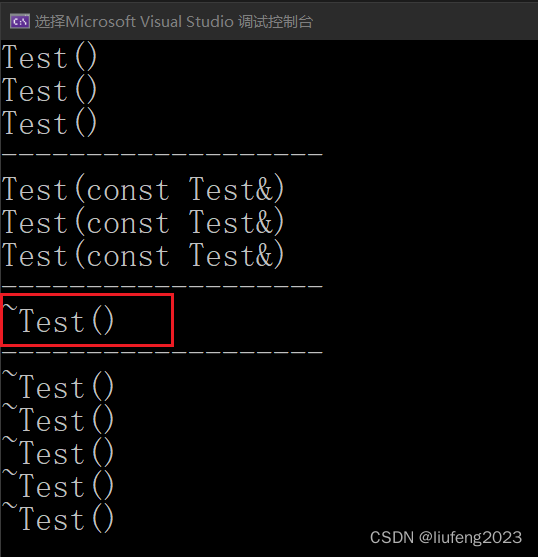
- pop_back调用了析构函数,将对象析构了!
- push_back时,这里是在底层针对t1t2t3调用拷贝构造了对象
























 被折叠的 条评论
为什么被折叠?
被折叠的 条评论
为什么被折叠?










